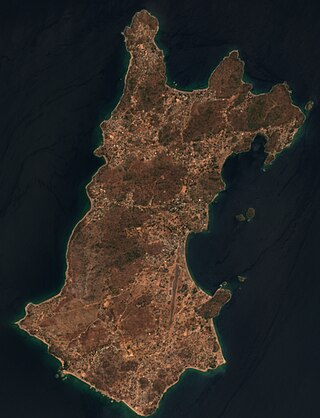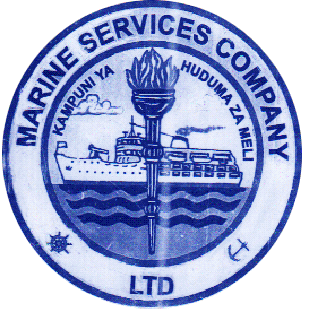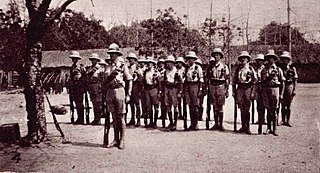
Lake Malawi, also known as Lake Nyasa in Tanzania and Lago Niassa in Mozambique, is an African Great Lake and the southernmost lake in the East African Rift system, located between Malawi, Mozambique and Tanzania.

German East Africa was a German colony in the African Great Lakes region, which included present-day Burundi, Rwanda, the Tanzania mainland, and the Kionga Triangle, a small region later incorporated into Mozambique. GEA's area was 994,996 km2 (384,170 sq mi), which was nearly three times the area of present-day Germany and almost double the area of metropolitan Germany at the time.

Nkhotakota (Un-kho-tah-kho-tuh) is a town and one of the districts in the Central Region of Malawi. It is on the shore of Lake Malawi and is one of the main ports on Lake Malawi. As of 2018, Nkhotakota had a population estimated at 28,350. The district had a population of 301,000.

Mangochi, originally known as Fort Johnston, is a township in the Southern Region of Malawi located near the southern end of Lake Malawi. As of 2018, it has a population of 53,498.

Likoma Island is the larger of two islands in Lake Malawi, in East Africa, the smaller being the nearby Chizumulu. Likoma and Chizumulu both belong to Malawi, and together they make up the Likoma District. Although both islands lie just a few kilometres from Mozambique, and are entirely surrounded by Mozambican territorial waters, they are both exclaves of Malawi.

Lake Victoria ferries are motor ships for ferry services carrying freight and/or vehicles and/or passengers between Uganda, Tanzania, and Kenya on Lake Victoria.

Mbinga District is one of the five districts of the Ruvuma Region of Tanzania. It is bordered to the north by the Njombe Region, to the east by Songea Rural District and Songea Urban District, to the south by Mozambique and to the west by Lake Nyasa. The district is partly home to the Liparamba Game Reserve. Notable people are Oscar Kambona, former minister of foreign affairs.

Nkhata Bay or just Nkhata is the capital of the Nkhata Bay District in Malawi. It is on the shore of Lake Malawi, east of Mzuzu, and is one of the main ports on Lake Malawi. The population of Nkhata Bay was 14,274 according to the 2018 census. Nkhata Bay is 413 kilometres (257 mi) from Lilongwe, Malawi's capital city, and 576 kilometres (358 mi) from Blantyre, Malawi's second-largest city. Nkhata Bay is the second "busiest resort" on Lake Malawi.
Kasanga, known as Bismarckburg during the German colonial rule, is a town in Rukwa Region, Tanzania. It is located at around 8°27′30″S31°8′10″E, on the shore of Lake Tanganyika, 810 m above sea level.
The Tonga are an ethnic group living in northern Malawi on the shores of Lake Malawi in Nkhata Bay and northern part of Nkhotakota. Their language and Tonga people of Zambia and Zimbabwe belong to different branches of the Bantu family.

MV Liemba, formerly Graf Goetzen or Graf von Goetzen, is a passenger and cargo ferry that runs along the eastern shore of Lake Tanganyika. The Marine Services Company Limited of Tanzania sails her, with numerous stops to pick up and set down passengers, between the ports of Kigoma, Tanzania and Mpulungu, Zambia.

Hermann Wilhelm Leopold Ludwig Wissmann, after 1890 Hermann von Wissmann, was a German explorer and administrator in Africa.

Tanzania Ports Authority (TPA) is a parastatal public corporation acting under the aegis of the Ministry of Infrastructure Development, that has the responsibility "to manage and operate" the ocean ports and lake ports of the country of Tanzania. The Tanzania Ports Authority headquarters are located in Mchafukoge ward of Ilala District in Dar es Salaam Region. It is a member of the Port Management Association of Eastern and Southern Africa.

Marine Services Company Limited (MSCL) is a Tanzanian company that operates ferries, cargo ships and tankers on three of the African Great Lakes, namely Lake Victoria, Lake Tanganyika and Lake Nyasa. It provides services to neighbouring Burundi, DR Congo, Zambia and Malawi.

William Percival Johnson was an Anglican missionary to Nyasaland. After education at Bedford School (1863–1873) and graduation from University College, Oxford, he went to Africa with the Universities' Mission to Central Africa, under the Bishop Edward Steere.

Hermann von Wissmann was a German steamer on Lake Nyasa named after the German explorer Hermann von Wissmann who had raised funds for the vessel to be built in 1890 as an anti-slavery gunboat.

SS Gwendolen was a British steamship on Lake Nyasa that fought in the first naval action of World War I against the German steamship Hermann von Wissman which it caught on a slipway at Sphinxhafen, now known as Liuli.

Malawi and Tanzania have formal relations.

The Mtwara Development Project is a major infrastructure development project involving southern Tanzania, northern Mozambique, eastern Malawi and Eastern Zambia. The goal of this project is to provide road, rail and waterway access from the surrounding region to the Port of Mtwara. The region and the corridor has been neglected by the respective governments for over 40 years and the recent discovery of oil, gas and various minerals has kick started the development of the project. A road and rail link is to be built from the port of Mtwara to Mbamba Bay on Lake Nyasa to link Malawi to the corridor and further road links into Mozambique will facilitate access to northern Mozambique.

The Nyasaland Volunteer Reserve (NVR) was a British Colonial Auxiliary Forces unit raised in the British protectorate of Nyasaland. The British Central Africa Volunteer Reserve was formally established by the colonial government in 1901 and was renamed when the protectorate became Nyasaland in 1907. In the initial years the unit was little more than a rifle shooting club with no uniform and no military training. The NVR was placed on a more formal standing in 1908 under the Volunteer Ordinance. This implemented residency and racial requirements for membership and made provision for the unit to be mobilised by the governor. The unit was initially formed of four sections but grew to seven sections by 1914 and by 1930 the unit had ten.



















